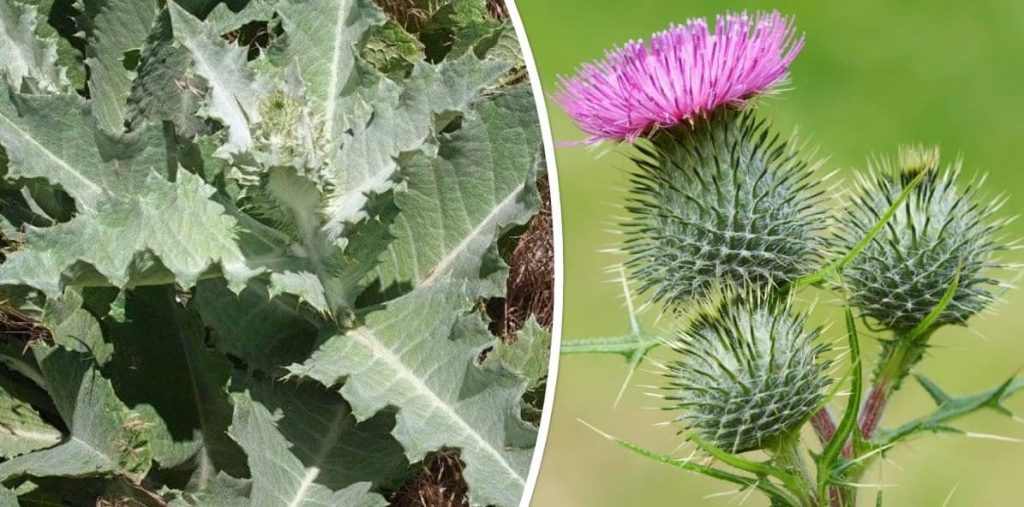Do you know how to get rid of thistle weeds in your lawn garden? Before controlling the thistle, you should know about its nature. In this article, I will tell you the necessary things on how to get rid of thistle weeds in 15 ways in both natural and chemical ways. So, let’s go step by step and follow the practices carefully, don’t be so hasty.
What is a Thistle:

Thistle (Cirsium arvense) is one of the most stubborn herbaceous weeds of the daisy family that spreads using lateral roots and airborne seeds. It is harmful enough for your lawn; also, it is classified as a noxious weed in many countries and states.
You are already familiar with the term weeds. Weeds are unwanted or undesired plants that grow in your lawn. You have to get rid of these weeds if you desire a kid-friendly yard, as they can spread quickly in your grassland areas and borders. But it is not an easy task for you to remove it permanently to get a kid-friendly lawn.
Creeping thistle:
Creeping thistle is one kind of weed that spreads through lateral roots. The creeping thistle grows well on an extensive root system that can go quite deep into the ground. These weeds can regenerate in broken conditions. The roots are brittle and produce buds at intervals. You must control these weeds to make your lawn healthy and evergreen. Weeds compete with grass for light, water, and food.
How do thistle harm your lawn?
Before controlling, let’s know how thistle weeds damage your lawn. Thistle is thorny and spiny, a seed-producing plant spreads and covers your whole lawn very quickly. Thistle can generate 120,000 seeds from one flower. If it happens, it will be different to eliminate these from your yard. Sometimes it needs several years to eliminate. That innocent-looking thistle can grow up to six feet tall. If you had seen thistle for the first time on your lawn, you would have taken immediate action as soon as possible. Otherwise, it will have even more the next.
When thistle grows?
You can find two types of thistle, either they are biennial or even worse-perennial. Biennials are generated well in summer and fall, and they generate numerous flower heads in the next spring. Perennial can be seen all year-round.
Time to control thistle
It is the best time to remove thistle when they are growing vigorously before producing flowers. You have to wait for the best time of the growing period of thistle. It will become very harmful for your lawn if you remove them after producing flowers and seeds. The flowers contain many thistle seeds that can spread throughout your yard. You can dig them up at any time of year when they emerge. You can also control them by using both chemical and non-chemical methods.
How to get rid of thistle weeds in natural and chemical ways
You can control thistle in both natural and chemical ways that are given below.
Natural or non-chemical control:
It is one of the best options for you to control the thistle without using chemicals. Also, it is very advantageous and efficient for your lawn because sometimes chemicals can cause serious damage to your yard. So, here are the natural control-
Dig them up: It is the easiest method to dig up the thistle. Sometimes, it is ineffective because when the roots become brittle, they can quickly regenerate from the broken pieces. So, you have to become persistent and dig up the whole plant along with its roots. Use a sharp weeding tool to remove the roots along with the plant. It is very significant to remove large weed plants, and thistle roots are 20 ft deep. You have to follow multiple strategies to dig out if roots spread very deeply. Don’t keep the thistle roots or shoots into the compost pile because they may regenerate again in the following year.
Cut down the top: It is a very effective and one of the best methods to cut down the top of the thistle at the soil level to stress the roots frequently and weaken them by cutting over several years. You have to do your job before the flower heads show color. This is effective for the random thistle, not for an extensive infestation. When it is creeping thistle, the best cutting time is early June, when it reaches 4 to 6 inches (10 to 15 cm) long. Don’t let the flowers dry out because they can spread seed very shortly.
Plant densely: Thistle needs a lot of sunlight and water. Baby thistle is sun-loving weeds, and it germinates in empty, unshaded soil, so plants densely around it. After the plants become mature, they can give shade to baby thistle. That’s why it becomes weak and killed. Now the plant regularly is best to quickly rebound the weeds.
Cover it: Cover the newly born weeds as soon as possible. It can eradicate thistle spreading. You have to follow a mulching guide that’s best for your lawn. Mulching makes your desired plant healthy by conserving soil moisture, and it obstructs the growth of new thistle and other weed plants.
Mow your lawn: Mow your yard when you have seen the thistle start to reserve seeds and keep it away. It is essential to collect and remove the thistle plant at the early bud growth stages before spreading new seeds.
Improve soil fertility: Improve your soil fertility as far as possible to weaken the thistle. It helps the desired plant grow well and compete with the thistle, thus weakening and dying the thistle and other weeds.
Spray white vinegar: Pour household white vinegar into a spray bottle and spray it directly onto the thistle plant until the plants are dripping. You need 1 or 2 sprays, and you will see it kills the weeds after a few days. Avoid spraying when it has a possibility of rain because it washes away your vinegar, and you will need a second application. Household vinegar concentration is only 5% which is very weak, so you have to purchase at least 20% concentration vinegar to get rid of thistles. Though it is not safe to consume, it can kill the thistle in a short time.
Pour Epsom salt: Epsom salt prevents the natural flow of nutrients to plants. So, sprinkle it directly at the base of the thistles and notice that it doesn’t go in contact with other plants as it can kill any plant. Use regular Epsom salt from the store or online. It will be harmful to magnesium, requiring weeds as it can grow them well.
Use organic herbicides: For more effective results, you can purchase commercial-based herbicides formulated to kill the weeds. Read and follow the instructions labeled on the package carefully. You can purchase it from the local store or online. Make sure which is best for your lawn. Use them cautiously because they can kill other plants.
Place the livestock in the thistle field: If you have a large lawn, let the livestock on it, and they will snack on the thistle. All livestock prefer young thistle very much. Also, some of the animals eat all the growing stages of the thistle. Your livestock doesn’t want to eat toxic thistles like milk thistle and Italian thistle, ensuring it is edible for livestock.
Introduce beneficial insects: Many beneficial insects can enjoy eating thistle and let them die. So, release the beneficial insects to your lawn and monitor them.
Remove excess thatch: Lawn thatch is a layer of dead and living organic material between the grass and soil. You have to remove excess thatch from your lawn as it can contain weed seeds, and it prevents the normal growth of your lawn grass. And where the grass is not grown, weeds take place there.
Soil aeration: Compact soil is nutrient deficient soil. It hinders the nutrient supply in your grass, thus obstructs the normal growth of lawn grass. So, you must relieve soil compaction by aerating, making it easier for the grassroots to grow and establish and get a healthy lawn full of healthy grass.
Chemical control:
It is the most effective method to control the mature thistle, blooming size plants, and large infestation from your lawn because they give you a quick result. The best time to apply the chemicals is sunny days when the temperature fluctuations are 65 to 85 F (10-29°C).
Apply in the grass
Selective weedkiller: Apply selective weed killer containing Clopyralid, i.e., Monterey LG5482 Thistledown Weed Killer to control the weeds well. This method is typically best for large areas and the land overgrown with thistle.
- You need to apply the weedkiller several times.
- You can find it in a local store gardening or online.
Selective herbicides: Apply selective herbicides based on Triclopyr, i.e., Vitax SBK Brushwood killer in rough grass.
- Mix the herbicide in a container according to the recommendations.
- Apply it directly onto the thistle plant to kill it.
- When you spray, wear personal protection equipment (PPE).
- The best time for applying this herbicide is Spring and Fall when the plants are in the active growing period.
Apply in borders and unplanted areas
Systemic weedkiller: Apply systemic weedkiller which contains glyphosate, i.e., Roundup Fast Action, SBM Job done General Purpose Weedkiller or Doff Glyphosate Weedkiller, or for spot treatment use Roundup Gel. You need to apply them before the flower heads show color. This is an excellent option for flower beds and borders.
- You can find this weed killer in a local gardening store or online sources.
- When the foliage turns yellow after a week, you must apply the weedkiller entirely on the foliage.
- If you have seen any signs of the regeneration of weeds in the following year, you need another two or three treatments.
- Follow the principles of the packaging of weed killer carefully.
- This weed killer can kill anything which comes in contact with it, so avoid spraying in windy weather.
Recommended thistle weed killer

Fertilize at least once a year
Follow the fertilization principles at least once a year to supply the nutrients like N, P & K correctly. Every time you cut the grass, you will lose some nutrients away from the soil and back them up after a certain period. Use good quality and slow-release fertilizer at least once a year.
Final thought
Removal of thistles is not a challenging task, but you need to regularly observe your lawn. If you have seen any signs of sprouting thistles or other weeds, fix it as soon as possible if you want a healthy and evergreen lawn. It is not difficult to kill and remove the thistle. Just you need to follow some of the basic knowledge and willingness to do it.



